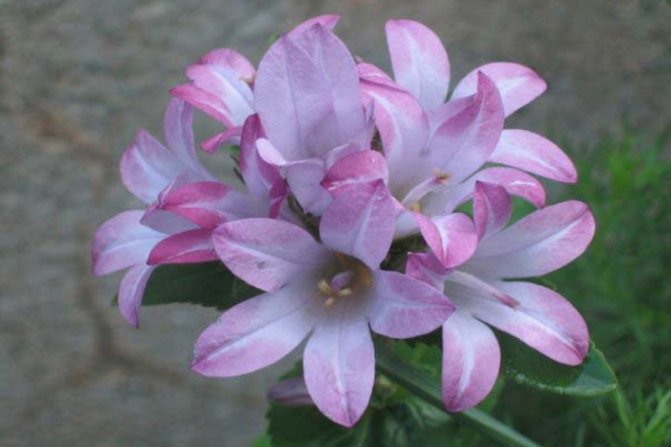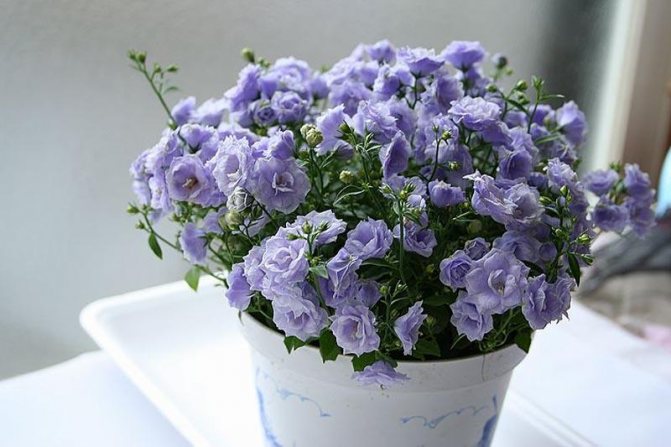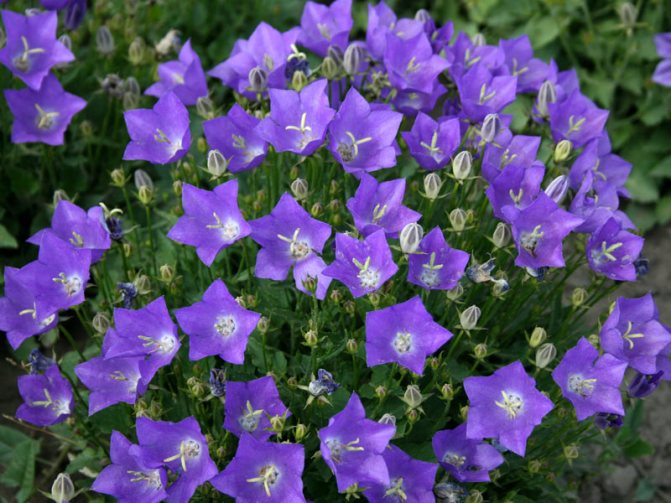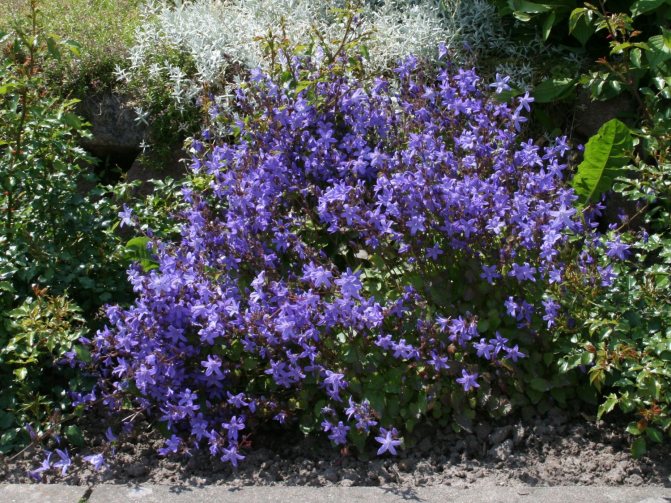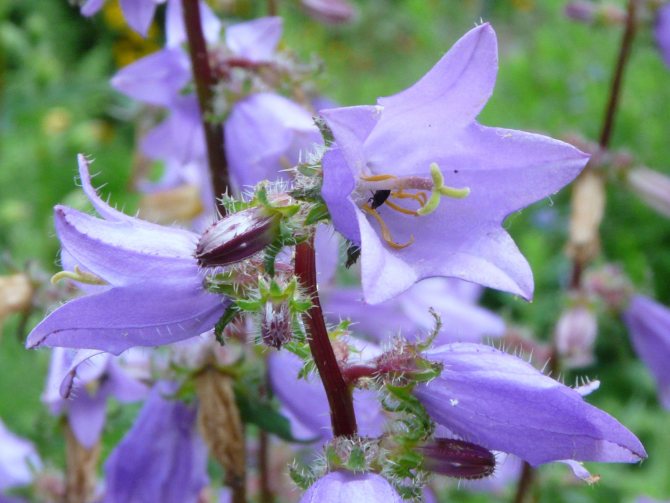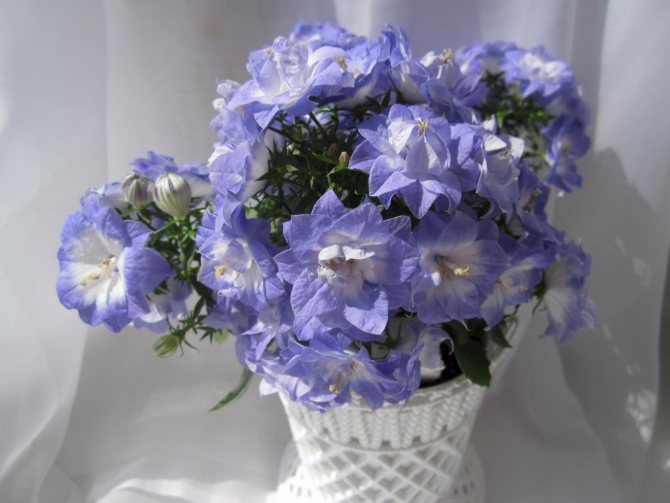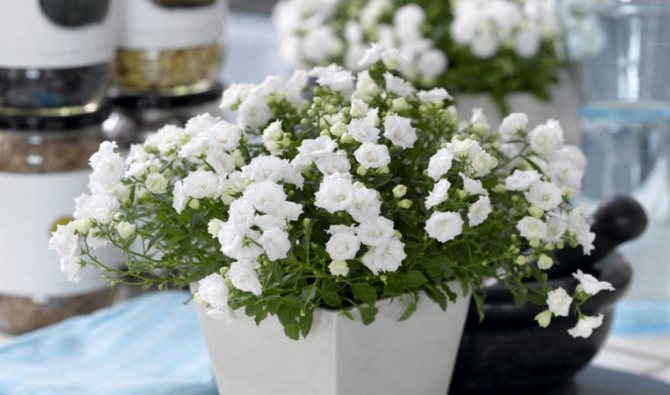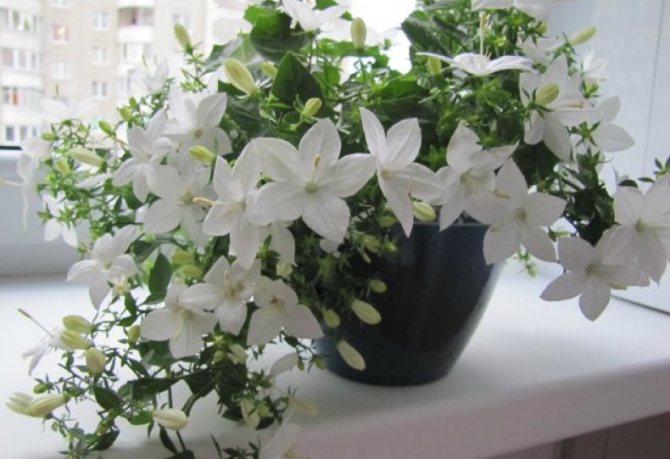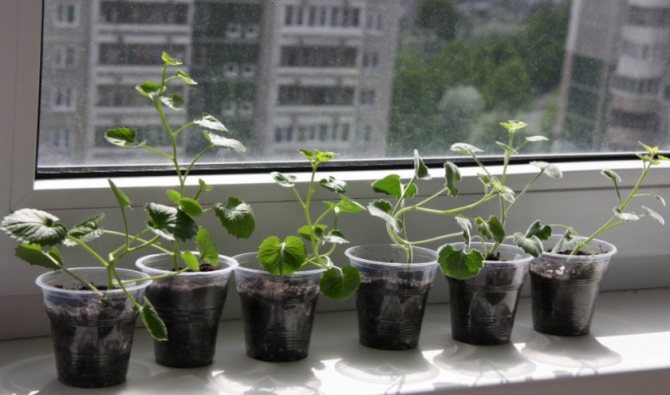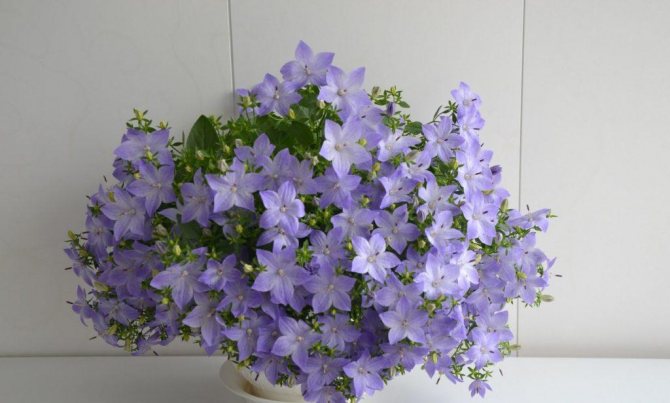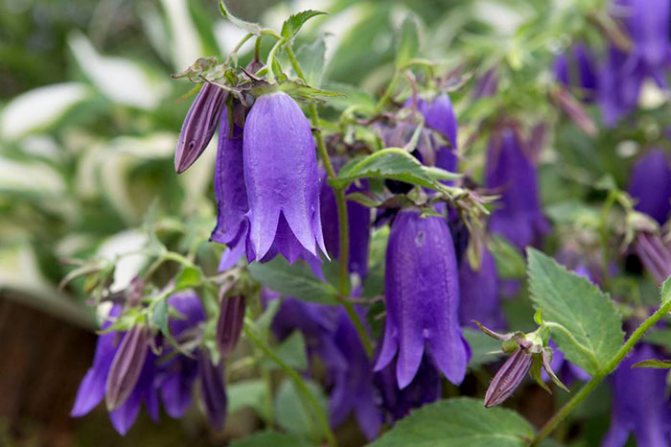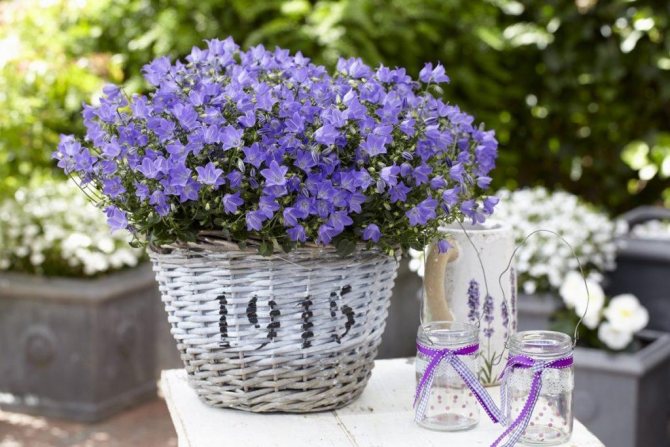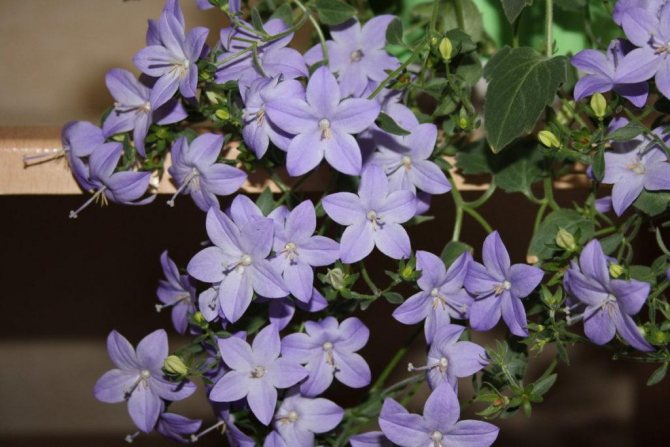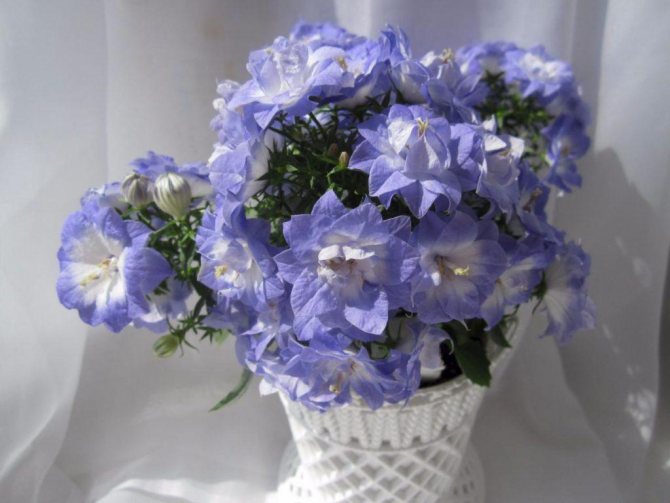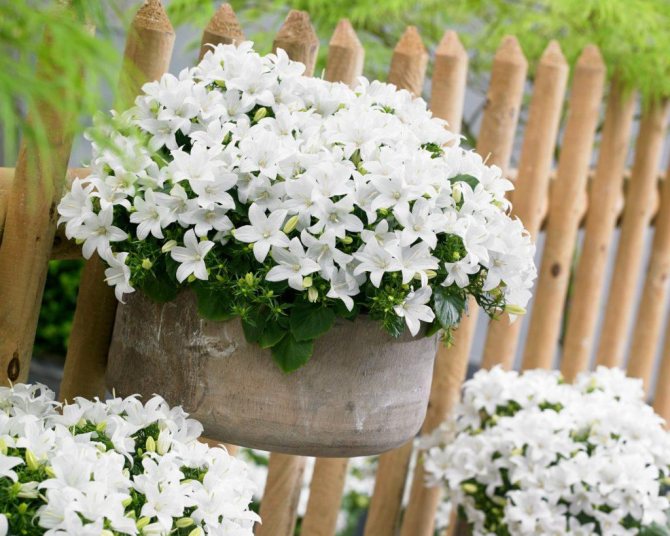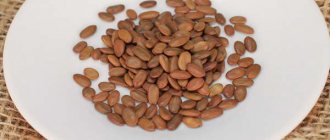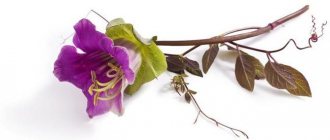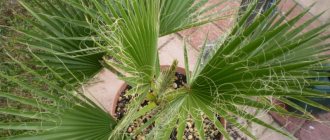
An indoor herb belonging to the Campanulaceae family is called campanula.
It is distinguished by significant decorativeness during flowering, more often found in the ampelous variety.
Numerous flowers are white, blue, purple or pink in color.
With a height not exceeding 40 cm, Campanula is presented in a variety of varieties intended for both garden and indoor cultivation. Wild species are also known.
The homeland is considered the Mediterranean, although now the plant has spread throughout the world.
Description
Campanula garden is undemanding to growing conditions, it grows in various places - forest, steppe, rocks and wastelands. The homeland of the flower is the Mediterranean countries, it grows well in regions with a temperate climate - in Asia, North America, in the Caucasus.
The plant is herbaceous, perennial, the stem can be straight or creeping, up to 1 m long. The leaf blades on long cuttings are cordate, about 7 cm long. The shape of the inflorescences is pyramidal. Flowers up to 4 cm in diameter, various shades: white, purple, blue, pink, etc.
The flowering phase begins in June and ends in September.
Garden campanula is a perennial moisture-loving crop that needs regular watering, especially in the phase of active vegetation and flowering. The soil must be drained so that water does not stagnate, as the root system can rot. If you remove wilted flowers from the bush in a timely manner, you can activate and stimulate the formation of new buds. In October, the stems are cut, and the root system is insulated with fallen leaves or peat.
Diseases and pests of campanula
Ailments little affect the adult sample of campanula. Factors that undermine the health of a plant are often improper care, lack of fertilizers. For example, excessive moisture and insufficient illumination increase the risk of developing fungal diseases: powdery mildew, rust, etc. If you identified these infections from the photo, immediately spray the soil with foundation or products containing copper, potassium permanganate.
Of the pests of Campanula, ants, aphids and slugs have chosen. In this case, use special insecticides.


Campanula in the flowerbed
Views
Bellflower (Campanula lactiflora)
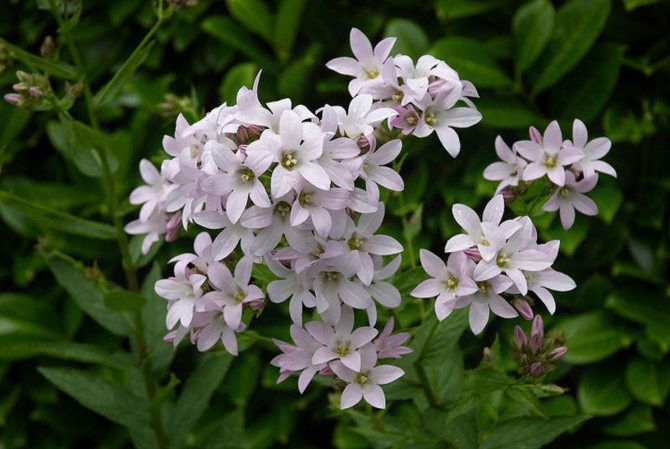

Bellflower (Campanula lactiflora)
The plant is perennial, with a branched stem about 90 cm long, photophilous. The diameter of the flower is about 3 cm, the shade is milky or lilac, the inflorescence is pyramidal.
Campanula carpatica
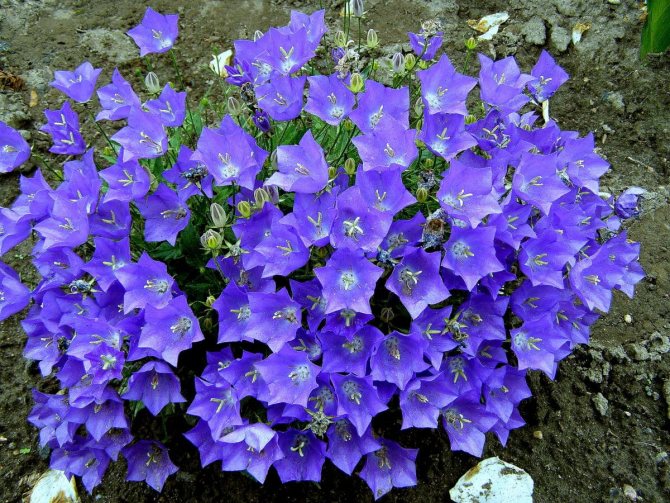

Campanula carpatica
In nature, it grows on the slopes of the Carpathians, Central European calcareous rocks. Decorative, unpretentious, long-flowering frost-resistant culture. The height of the bushes is about 40 cm, the stems are mostly erect, the shoots are covered with villi, branching. Leaf plastics of a green hue, slightly hairy, with veins, round-heart-shaped. The flowers are large, single, cupped, about 5 cm in diameter, shade of blue, white or purple, formed on the tops of stems and branches.
The flowering phase begins in mid-summer and ends in autumn.Used in the design of rock gardens and balconies.
Campanula peach (Campanula persicifolia)


Campanula peach (Campanula persicifolia)
The plant is up to 95 cm high, the leaf plates are similar to peach leaves, the flowering phase lasts all summer, the flowers are blue or white.
Campanula nettle (Campanula trachelium)
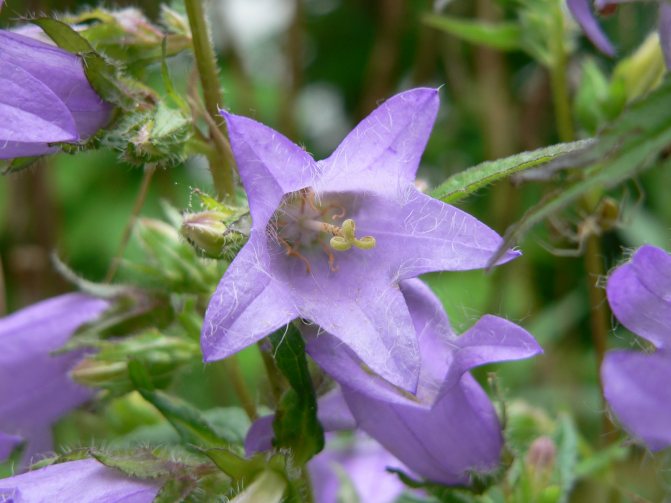

Campanula nettle (Campanula trachelium)
The stem is branched, straight, its height is about 1 m. The flowers are large, white or light purple. Blooms profusely until the end of summer. The leaf blades are serrated, rough.
Pozharsky's bell (Campanula poscharskyana)
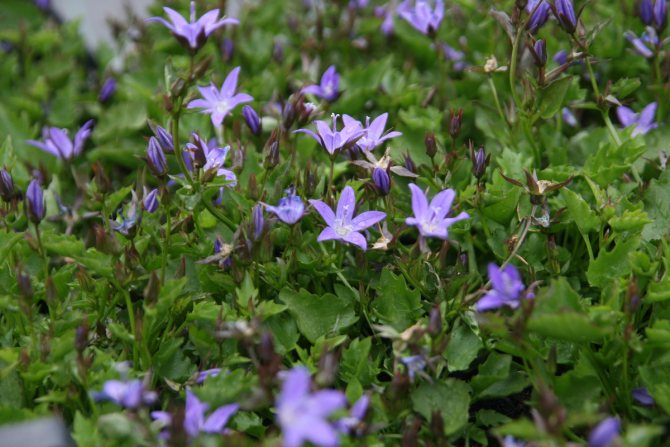

Pozharsky's bell (Campanula poscharskyana)
The leaf blades are round, creeping shoots, long, small flowers, up to 2.5 cm in diameter, bright lilac in color. Cold-resistant and shade-tolerant plant.
Crowded bell (Campanula glomerata)


Crowded bell (Campanula glomerata)
The plant is about 60 cm high, the stem is erect, rarely bristly. The root system is fibrous, the leaf plates are alternate, smooth on top, bristly on the back, elliptical in shape. The flowers are bell-shaped, blue in color, the inflorescence is spherical. The plant is undemanding to soil conditions, frost-resistant.
Broad-leaved bell (Campanula latifolia)


Broad-leaved bell (Campanula latifolia)
It can grow up to 120 cm, the root system is well developed, it grows up to 15 cm in length. The leaf blades are ovate, slightly pubescent. Flowers of a lilac shade.
Bell middle (Campanula medium)
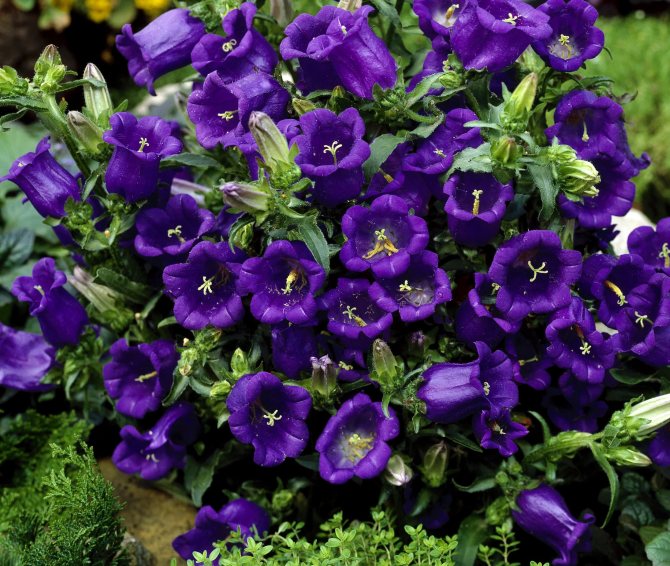

Bell middle (Campanula medium)
Height up to 1 m, branching stem, basal leaf blades have a lanceolate shape, narrow sessile leaves are located on the stem. The flowers are large, up to 7 cm in diameter, located along the length of the stem. They bloom alternately, the flowering phase lasts 60 days. The shape of the flowers is bell-shaped or goblet.
Possible problems
Growing this beautiful plant, sometimes you have to face the following problems:
- leaf blades become faded or acquire a yellow tint - the flower may grow in the wrong place. It is necessary to choose a place for him that suits his growing conditions, to prevent the sun's rays from entering the plant;
- the stems stretch and become thinner - the reason is insufficient lighting;
- foliage withers - the intensity of watering should be reduced.
Growing features
There are several things to consider when growing a plant:
- it is necessary to remove dried flowers in a timely manner. This stimulates the formation of new buds, so the flowering will be abundant;
- in October, the stems need to be cut off, and then the root system should be insulated with fallen leaves and peat;
- tall varieties should be tied up so that they do not bend or break from gusts of wind;
- the bush is updated annually, planting new cuttings;
- if the leaf blades begin to turn yellow from too bright rays, the bush must be shaded.
Soil selection and planting site
The site must be well lit, protected from wind gusts. The soil solution is neutral or slightly alkaline. The soil must be drained, before planting it must be dug up, weeds must be removed.
Fertilizers and feeding
In the phase of active vegetation (spring-summer), once every 14 days, the plant is fed with nitrogen-containing micronutrient fertilizers. After flowering, phosphorus-potassium fertilizers are applied.
Watering
The soil should be well moistened, it is recommended to water the garden campanula daily. In the fall, the amount of watering is reduced.


Loosening and weeding
Weeding is carried out regularly to prevent the growth of weeds, which negatively affect the development of the plant. After watering, the soil must be loosened to provide the roots with oxygen.
Transfer
The plant does not tolerate transplanting very well. If it still needs to be done, it is best to do it at the end of August. Garden campanula should be transplanted together with an earthen clod so as not to damage the root system. The prepared depression in the soil is watered with water, the plant is placed in it and sprinkled with soil.
Pruning
In the second year of life, Campanula garden forms several peduncles. This can cause depletion of the plant, so the excess peduncles are cut off. In the middle of autumn, the aboveground part of the bush is cut off, leaving 10-15 cm.
Wintering
The plant is cut, the roots are insulated with opal foliage or peat.
Flower propagation
One flower is good, but many are even better. If the campanula has taken root well and has grown, it can be planted. It is better to do this in early spring, and if the plant roots are weak - in May, when the soil warms up enough. Experienced gardeners recommend planting healthy flowers every year.
Another way to propagate campanula is by cuttings. To do this, cut off shoots with 2-3 leaves. Healthy and strong cuttings should be kept for 7 hours in a weak solution of potassium permanganate, and then leave the shoots in clean water. When the shoot starts to take root, it can be planted to a depth of no more than 5 cm. The sprouts are covered with polyethylene to preserve soil moisture. You do not need to water them; if necessary, you can only sprinkle them with water.
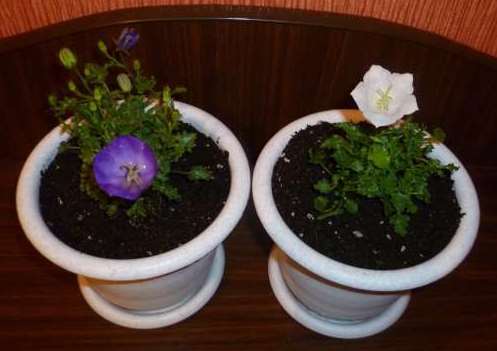

Bells description
Campanula (the second name is flowers like a bell) loves the sun, it ripens and grows very well on it. Bells have very nice features:
- In winter they are able to maintain their growth form and even their greenery;
- The plant is capable of self-cleaning. It does not need to be cut, cleaned, cut off the faded buds - it will cope with all this perfectly;
- They bloom twice a season;
- They serve as decorations. Looks beautiful in the garden or in the yard.
Usually two or three buds open a day. Basically, the flower can stay on the stem for ten to fifteen days. As soon as the flower has wilted, it must be cut off immediately. To make it bloom twice, you need to prune it after flowering. But you do not need to cut the stem itself, but the flowers. It is necessary to cut at the flower itself, leaving the leg, and a new beautiful flower will open to replace it. Campanula can bloom all summer long if you carry out this procedure. This plant is ampelous, grows quickly, in one summer season it can grow up to thirty centimeters. It has a large root system, so try to transplant it into a larger pot if necessary.
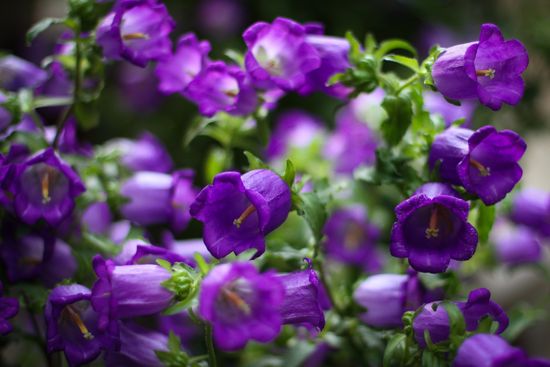

If the campanula began to abruptly disappear and wither, then she needs rejuvenation. The literature recommends doing it every two years, but we recommend doing it once a year. It is necessary to cut off the branches, but not the worst ones, but the most beautiful ones. Yes, do not spare the flowers, cut the most beautiful and blooming ones, then your campanula will give you fruits, and you will be glad that it blooms so well.
This plant will bring to your home the peace of mind that many housewives dream of. It is able to give harmony to the owners. Just try growing this plant and you will immediately feel a surge of strength and energy.
What does a bell look like?
The people called them that because of the shape that the campanula has. It really looks like a bell. This plant is very gentle and romantic. In your garden, it will look incredible and stand out brightly from other dull plants. The main thing is to take care of it, and it will delight you with its flowering more than once a season. We wish you a nice and blooming garden!
Bell in the garden: combination with other plants
The range of application of campanula for garden decoration is huge, as is the number of its varieties. Low-growing varieties in a tint combination with other flowering crops are a good landscape solution for borders, ridges, rockeries, balcony flower beds.Bells look good in the company of ferns or mallow.
Campanula occupies a niche of a universal decorative culture and is able to bring aesthetic pleasure with simple maintenance.
Description: varieties and varieties of bell
Campanula is a herbaceous perennial plant. It has the following characteristics:
- stem - erect or creeping, 0.4-1 m long;
- leaves - carved, heart-shaped, up to 7 cm in length, cuttings are long;
- inflorescences - pyramidal;
- color - from pale to rich lilac, pink, white, blue, etc.;
- flower size - 2-4 cm in diameter;
- flowering occurs from June to September.
Campanula is undemanding to care and grows in many places: forest thickets, dry steppes and wastelands, even in rocky areas. The plant has about 300 varieties. Photos and descriptions of popular species will help you choose the best one:
- The bell is milk-flowered. The plant is about 90 cm high and has a branched stem. The flowers are small, up to 3 cm in diameter, milky white or purple in color. Grows well only in abundant light.


Bellflower milky-flowered - Campanula Carpathian. A group of low-growing varieties with a stem no higher than 40 cm. It will grow as a bush in the form of a sphere 30 cm wide. Flowers up to 5 cm in diameter, blue, white or purple. Used to decorate balcony compositions or rock gardens.
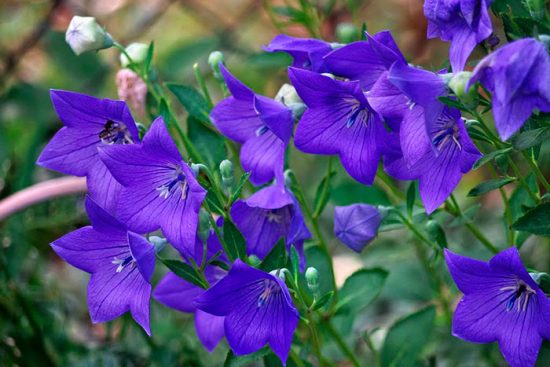

Campanula Carpathian - Campanula is peach-leaved. The bush reaches 90 cm. The leaves are peach-like. The flowers are about 3 cm in diameter, white or blue. The varieties are in the Red Book.


Campanula peach-leaved - Campanula nettle. A tall view with a meter stem. Flowers are collected in groups of 2-3 pieces. Color - white or blue (including shades). Some varieties have double inflorescences. Can develop normally in the shade.
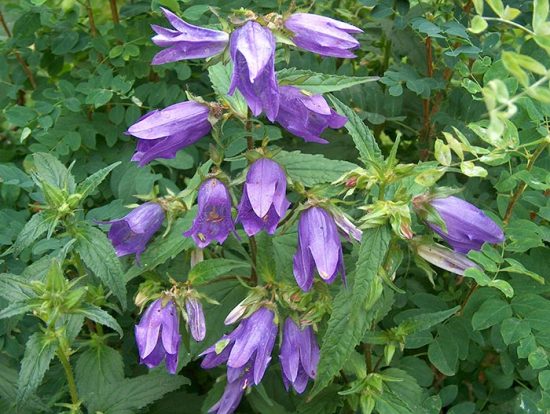

Campanula nettle - The bell is broad-leaved. The stem is over a meter in height. White or blue flowers in the form of large funnels are arranged in the form of an ear. Suitable for growing in the shade.
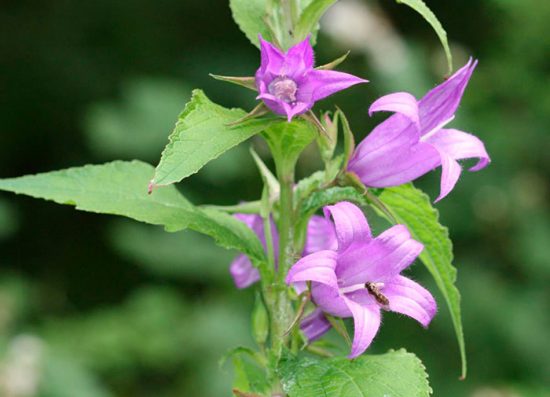

Broadleaf bell
Conditions for growing campanula at home
Campanula in flowerpots in the form of bells is a magnificent window decoration. It is called the plant of family happiness., believing that with her comfort, wealth and mutual understanding come to the home. The flower, unpretentious to natural conditions, is used for landscape design. A number of varieties are used for landscaping a room, home interior.
You can list the following of them, which do not present difficulties in leaving:
- Equivalent Campanula has small leaves. There are white and blue in color, which is inherent only in this variety, in everyday life called "Bride and Groom". This is an ampelous plant with shoots hanging from the pots under their weight.
- Carpathian, a perennial variety with rounded leaves and a wide variety of shades. A circle cap is formed in the pot
- loy form. The plant blooms throughout the summer season, after which it goes into dormancy.
- Blauronka with large leaves and blue flowers. The bush does not exceed 20 cm.
- Terry, demanding care. The flowers have petals arranged in several rows.
At home, the condition of the campanula depends on the regularity and quality of care. The moment of planting is important, getting used to the environment, nutrition, which predetermines adaptation and growth. But taking care of the flower pays off greatly. In the home interior, it becomes a real decoration. Its distinctive features are grace and bright bloom. Campanula suits many styles, both classic and Provence, country.
Important! This flower feels good on a windowsill, under a source of natural light. Other plants can be placed nearby. It also does not harm people with allergic reactions. Virtually odorless.
Location
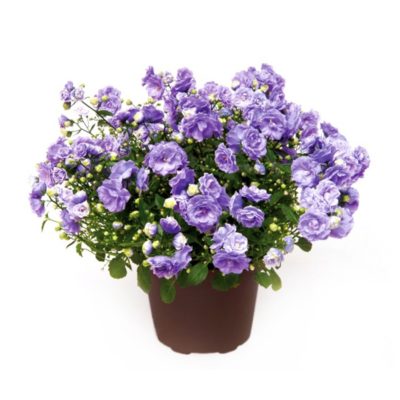

When choosing a place for location, you need to keep in mind that on the western and eastern windows show the best growth.
There is enough natural light, including sunlight. As a result, the plant develops well and grows.
The north side is usually not well lit, so the campanula is at risk.
Growth here requires backlighting with specially designed lamps. The southern window differs in that the direct rays of the scorching sun fall on it.
The plant may develop burns, it needs protection, covering it with various screens. You should not expose it to drafts, which are harmful.
Lighting
Campanula requires a lot of light... It grows poorly in the shade, it may die. To fully meet this need in warm seasons, it can be planted in a container behind a window or on a balcony, as well as in the ground. But direct rays from the sun should not hit the plant. The place must be provided with a shadow.
Temperature regime
The success of growing Campanula at home depends on the temperature. As well as other parameters of the microclimate in the place where it is located. It is necessary to arrange seasonal fluctuations in heat and humidity.
- In the spring, in the summer, they create a shade, the temperature is kept at +20 or +25 degrees C. Often watered, sprayed.
- In winter and autumn, it is intensively illuminated at a temperature of +15 degrees C. Watering is rare, not sprayed.
Campanula garden: planting a plant
Most bellflower varieties grow well only in intense light or partial shade. Campanula loves light, slightly alkaline or neutral loamy soil.
High soil moisture with poor drainage is undesirable for plants. Therefore, if on your site groundwater is close to the surface, find some kind of hill or make it artificially for planting and growing a bell.
Advice. Wood ash will help reduce the acidity of the soil. In combination with humus, add it to sandy soil. It is better to dilute clay soil with sand or peat.
The landing site should be dug up in the fall. Get rid of the roots of the weeds that strongly oppress the bell. Then add organic matter. Plant seedlings usually require rearing. Therefore, in May, determine for them a temporary place in the open field.
At the end of summer, carefully transplant the seedlings to a permanent location. To do this, make holes about 10 cm deep. Pour a large amount of water over the soil and wait for it to absorb. Leave at least 30 cm between the bushes when planting. Gently sprinkle the seedling in the hole with soil and trample the soil.
Adaptation of shop campaigns
A flower purchased from a store should be immediately transplanted into a new pot. If this is not done, then the plant will begin to fade gradually. This is due to the fact that the stores use a thin pot that is not suitable for constant use.
- Water the campanula abundantly four hours before transplanting;
- Prepare a new pot, soil and fertilizer in advance. It is better to add leafy earth to the soil;
- Remove the flower and transplant it without removing the roots from the soil in which they were previously;
- Water the plant abundantly;
- Place in the shade and reduce watering to a minimum.
Bellflower: plant propagation
Reproduction of campanula can be carried out by seedlings, dividing a bush or cuttings. Terry or semi-double varieties are obtained only by vegetative methods, if the task is to preserve the properties of the mother plant. The beginning of summer is the optimal time for propagation by cuttings. To settle down in a new place, they will need about 1 month. and minimal maintenance:
- cut the annual flowering shoot from a healthy adult plant;
- plant in loose soil;
- shade the shank.


Even a novice florist can handle the reproduction of campanula.
Reproduction by division is planned for the end of spring or summer. The plant is removed, several parts are formed from it.Each should have aboveground and underground parts, as well as several growth buds. After that, the cuttings are immediately planted in open ground.
Attention! For annual species of bellflower, only seed reproduction is possible.
To properly harvest the seeds, wait until the capsule matures to a dark brown color. Then proceed like this:
- dry the seeds;
- in October, plant them in open ground and sprinkle them with a thin layer of soil;
- water if the soil is dry.
With proper care, you will see seedlings in April-May. They are planted in a permanent place in June or July. Seedlings can also be obtained at home:
- find a wide container, because the root of the plant is quite large;
- plant seeds after watering the soil in a pot;
- do not deepen the planting material, but scatter it evenly over the surface;
- build a mini greenhouse;
- open it for 15 minutes once a day, ventilate and spray the greens with a spray bottle;
- for open ground, seedlings will get stronger in about 20 days.
General information
Campanula is 20-30 cm high. Flowers have a very faint, almost imperceptible smell. It is believed that campanula gives the owners of the house family happiness, prosperity and wealth.
For reference: Blue and white flowers are called "bride and groom", and pink - "lovemaker." If you put them next to each other, then quarrels will appear in the house.
There are 350 different varieties of Campanula. These are mainly garden or wild plants. But there are also types of indoor campanula, for growing throughout the year at home. These flowers are unpretentious to care for. Anyone can cope with them.
Advice: Campanula can be used as a gift. It will replace a bouquet of flowers and will in no way concede in beauty.
Description and types of plants
Campanula have wide straight stems or thin curly, depending on the variety. In height, its size may also vary. There are specimens that barely reach half a meter, while others can grow up to one and a half meters.
Campanula is popularly called the "bell" because of the flowers, which are shaped like a small pyramid and resemble a bell. The flowers themselves are small - only 2-4 centimeters in diameter.
The color of the flowers of the garden campanula is very diverse and even the most fastidious florist will be able to choose a suitable shade of both pastel color and bright and saturated.
The garden campanula blooms throughout the summer and can even capture the beginning of autumn. The bellflower is widespread in wooded areas, in fields and meadows, and in other areas. More than three hundred varieties of plants are known, each of which is beautiful in its own way.
The following types can be distinguished from the garden campanula:
- peach-leaved - its inflorescences can have a blue or white tint. Usually the flowers of this variety open in June, and their seeds ripen by August. The name "peach-leaved" comes from the leaves of the plant, which resemble peach. On average, they usually do not reach a height of a meter, that is, they can be about 60-80 cm. This species includes the Telham Beauty, Snowdrift, Fleur de Neige and Snowdrift bell varieties.
- broadleaf type of bell - the main difference between this species is the flowers, which are quite large in size and are located on the top of the stem. The colors are purple and white, and the plant blooms around the month of July. Seeds ripen closer to mid-August. The stem can be over a meter in length. The leaves extending from the root are also quite long, but closer to the top, on the contrary, are small. The most common mortas of this type are "Makrantu" and "Brantwood".
- is an equal-leaved species - it has a low stem and long flowering (it can bloom throughout the summer period). There are many small bells on the eust, which can have a blue or white tint. The most popular varieties of this type are "Albu" and "Maya".
- nettle-leaved form - has voluminous inflorescences of a pale purple hue or white. May bloom until August. The stem is about a meter long. Leaves are slightly rough.
- Carpathian species - has large cupped flowers about 5 cm in diameter and a low stem (up to 40 cm in total). There are varieties of white, sky and purple hues. It differs in the shape of the leaves - they are ovoid. This species of Campanula blooms until October.
- crowded form - has thick shoots of medium length. There are blue, white and lilac flowers that fade by mid-August. The most common varieties of this species are Superba and Akulis.
Temperature regime
The beauty of this flower is largely influenced by the air temperature, which should be in the range from 17 to 22 degrees. Campanula does not tolerate heat very well, especially in winter it is important to withstand suitable conditions. Warm hibernation can be disastrous. In this case, in the spring you can not wait for flowering, or it will be very scarce. The most comfortable temperature for this plant in winter is not higher than 15⁰С, and even better if it is 5–10⁰С. It is recommended to remove the flower during the heating season away from the batteries or place it on a glazed loggia, if there is one.
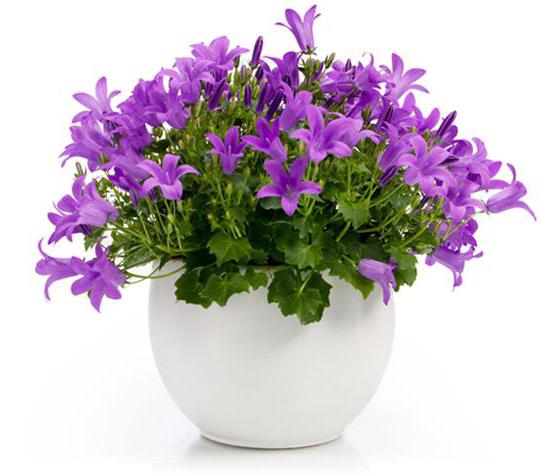

How to plant garden campanula
A perennial plant of this species can be planted and transplanted in both autumn and spring. You can propagate it in several ways:
- using cuttings;
- using seeds;
- dividing the bush.
The easiest way to propagate this bell is by cuttings. All that needs to be done is to cut off a branch from the bottom of the shoot and put it in the water. However, two points should be taken into account: the leaves should not be dipped in a container of water and the branch should be cut with a very sharp knife.
After a while, the cuttings should have roots and can be planted in a pot of soil. For the soil, you can use a peat-sand mixture.
The stalk can not be watered, but only sprinkled with water from time to time. It should be allowed to take root properly and after that it can be transplanted into open ground.
The flower can also be planted with seeds that ripen after flowering. It is customary to sow them in open ground in the autumn. If you sow them in the spring, then it is better to first grow seedlings for this by planting the seeds at home in a pot. The soil should be well moistened before planting.
For planting seeds, holes are made, about three centimeters deep. From above, the seeds are sprinkled with earth and after that they should be well watered. Experts believe that planting the seeds of this perennial should be done towards the end of October. Shoots will begin to show immediately after the snow melts
As for planting a garden bell in the spring, the month of March is considered the best for this.
Reproduction by dividing the shrub is an excellent option for those who are engaged in the constant cultivation of perennials and who already have these beautiful flowers in the garden. Reproduction by dividing the bush is carried out after the flower fades and for this it must be dug up and divided into several parts. It is necessary that there is at least one renewal point on each separated bush.
After dividing the bush, the seedlings are planted in prepared soil and watered. Campanula takes some time to root and so that it does not disappear, it is better to do this no later than September.
Campanula landing and transplanting rules
You can plant and transplant a perennial in spring or autumn.
Flower reproduction occurs:
- By cuttings. Cut off the shoot from the bottom of the shoot with a sharp knife and place in a container of water so that the leaves remain on the surface.After the roots appear, plant the cutting in a pot of peat and sand mixture. You don't need to water the sprout, just spray it with water. When the stalk is strong, transplant it into the garden.
- Seeds. They are planted in the fall in the ground or in the spring in pots or a greenhouse. Spread the planting material on moist soil and sprinkle with 3 cm of soil. Water again abundantly. In autumn, do the procedure at the end of October. Seedlings will appear 3-4 weeks after the snow melts. In the spring, plant in March. Cover the seed container with glass or plastic and ventilate the seedlings periodically. At the end of May, the plant can be planted in the garden.
- By dividing the bush. Dig the mother bush in late summer or September and divide it into 2-3 parts. Make sure each has at least 1 resume point. Plant a portion of the root in a permanent location. Before the onset of frost, the seedlings will have time to take root.
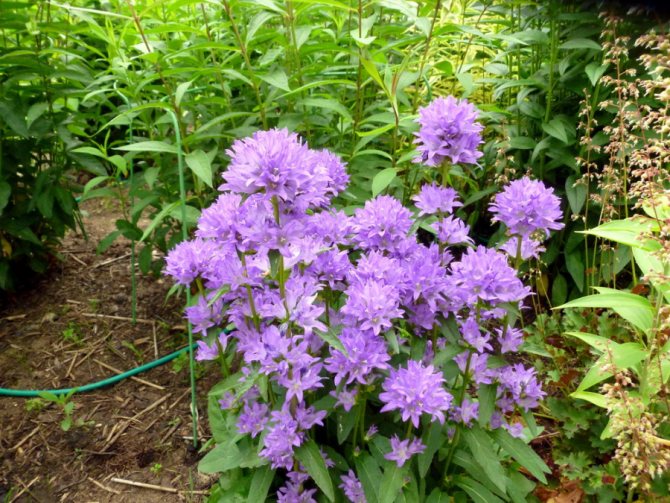

Where to plant or transplant campanula:
- First of all, prepare the site for future planting / transplanting. The land should be dug up and cleaned of weeds (dig them up by the roots).
- The area should be illuminated by diffused sunlight. Partial shade is allowed.
- Choose a draft-free location.
- The preferred soil composition is alkaline or neutral. Add peat and sand to clay soil, and humus and wood ash to sandy soil. The main thing is that the soil is loose, allowing the roots to breathe.
- Avoid low-lying areas and other areas of permanent stagnation of water.
During transplantation, transfer the plant to a new place with an earthen lump.
In order not to damage the roots, do not shake the plant or knock the soil off it. Pour the dug holes with water, place a bell in them and sprinkle them with earth on top.
How to care for a garden campanula
The bell is a rather unpretentious plant, but in order for it to grow well and delight the grower with abundant flowering, you should know some rules for caring for it. First, it should be noted that campanula is a moisture-loving plant, therefore, soil moisture must be monitored daily. He especially needs water during the growing season and during the flowering period. Sometimes, in dry weather or in dry climates, the plant requires watering twice a day.
However, with abundant watering, care should be taken to ensure that there is no stagnation of water, otherwise the roots may begin to rot. Therefore, before planting, you should take care of the drainage system.
In addition, flowers that have already bloomed should be removed. This will lead to the fact that new buds will begin to form, and accordingly the flowering will be longer and more abundant.
The perennial should be prepared for winter annually and covered with foliage and peat to prevent it from freezing.
The plant is good for feeding. This is usually done three times per season:
- The end of April-May is suitable for applying nitrogen-containing fertilizers that promote good growth and development of young foliage.
- When the buds begin to set, they are fed with the help of complex mineral fertilizers.
- When the bell is already in bloom, you can use phosphorus and potassium fertilizers.
Watering and fertilizing
Campanula is a moisture-loving plant. Especially during the period of growth and flowering. Water the flower daily in small portions of water. In a particularly dry summer, watering can be increased up to 2 times a day (morning and evening). Overdried soil can kill a plant in a few days.


Use warm water for irrigation. Carefully monitor the soil moisture. Stagnant water is just as damaging to bells as drought. In the fall, gradually reduce the watering process.
Flower fertilization recommendations:
- Perennial needs feeding in spring and summer.
- campanula does not tolerate fresh manure, this type of fertilization leads to root rot.
- feeding is undesirable to carry out more often than once every 2 weeks.
- in early spring, apply nitrogen-containing fertilizers to the soil.
- before flowering (presumably in May), fertilize the bell with minerals.
- after flowering, the perennial can be fed with potassium and superphosphate.
Campanula, description of the culture
Campanula is a numerous genus of herbaceous plants belonging to the Bellflower family. The birthplace of bells is the Mediterranean. In nature, they grow well in temperate climates - in the Caucasus, Asia and Siberia, North America. Campanula is a perennial, but there are also biennial varieties.
The growing area of bluebells is varied. They fill meadows, forest edges, steppes, and some species can be found on rocky areas and in wastelands, in the alpine mountain belt.
The name of the plant campanula has a scientific interpretation. It comes from Italian. campana, which in translation sounds like "bell" and fully characterizes the appearance of the flower.
- The plant has a distinct bell-shaped corolla, paniculate inflorescences, less often one-flowered. They can be simple and double, up to 2-6 cm in diameter. The leaves are beautiful green, whole, single.
- Bells are simple and at the same time exquisite plants, in color they are painted in pastel and bright purple, white, lilac colors. During the flowering period, in addition to a beautiful sight, you can catch a light sweetish aroma.
- The stems of the garden campanula can be dense and straight or slender and curly. The height of the shoots varies between 40 and 150 cm and is determined by the varietal characteristics.
- The flowering of bells lasts the entire summer season and is often delayed until the end of September.
- The fruit of the campanula is a capsule with several slit-like holes (usually 4 or 6 of them).
Many varieties of bells are endangered. They are massively collected for bouquets, mercilessly destroying their growing places. 12 species have already been included in the Red Book.
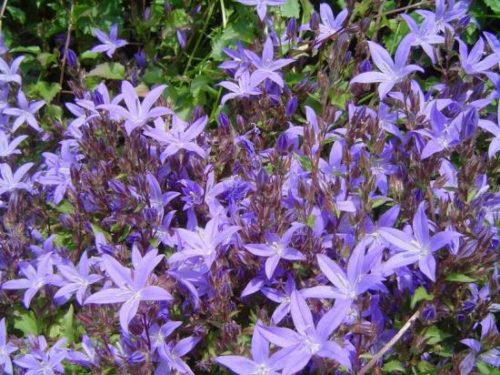

Watering


Campanula flower photo
In its natural conditions, campanula grows on rocky ground, therefore, it does not have special requirements for watering at home. But it is important to remember that the roots must “breathe”.
- Watering in the summer. During the period of the main development of the flower (spring-summer), abundant watering is required, since the soil must constantly remain moist, but it is not necessary to allow water to stagnate in the base of the flowerpot.
- Watering in winter. Already in the fall, watering should be reduced. In winter, especially if the plant is kept in cool conditions, watering should be done very rarely.
Also read about: “You just can’t be the owner
Types and varieties of campanula
There are 440 campanula species that have been studied and described in detail. But in gardening, only a few dozen are popular. Let's get to know the most beautiful of them.
Campanula Bell Pozharsky
A low twenty centimeter perennial found in the Balkans. It has creeping stems that extend 30 cm wide. The leaves are large and round, the flowers resemble graceful stars or small bells. It blooms throughout July, the color of the buds is pale blue, lavender, pinkish.
The species is quite hardy, it tolerates shade and frosts down to -40⁰С well. A well-known variety of this species is "Blayranka". It has star-shaped flowers, 2-3 cm in diameter and dark green foliage.


Campanula Carpathian
The flower was first discovered in the Carpathian forests, hence its name. Perennial up to 35 cm in height. Petiole leaves are small and collected in a rosette, basal leaves are larger and ovoid. Cup-shaped flowers do not exceed 5 cm in diameter, their color is sky-blue, snow-white, violet. Several beautiful varieties have been bred:
- "White Wonder" is a terry campanula. Large flowers outwardly resemble a fluffy violet, which stands out strongly among the green leaves. Often grown as an indoor crop.
- "White Star" is a variety with increased decorativeness, it has large semi-open inflorescences of a milky color.
- Blue Wonder is another potted terry campanula with violet-colored inflorescences.


Campanula nettle
A beautiful honey plant with leaves resembling nettles. In addition to being highly decorative, bells have medicinal properties and are used to treat colds. Also, young greens of this campanula are used in cooking for making soups and salads. Grows up to 70-100 cm in height, leaves are ovoid, sinewy; the flowers are small and painted in snow-white, pale blue or lilac. Flowering duration - 2.5 months.


Peach-leaved campanula
Perennial variety with wide bell-flowers of white or light blue color. Stems are erect, mostly bare, reach 90-140 cm in height. Leaves are dark green, narrow. The flowering period is June-July. Among the varieties stand out:
- "Alba" is a royal variety with luxurious snow-white flowers up to 5 cm in diameter.
- "Cerulea" - a variety with a fragile erect stem 60-70 cm high; inflorescences are large, blue-violet, collected in racemose inflorescences.
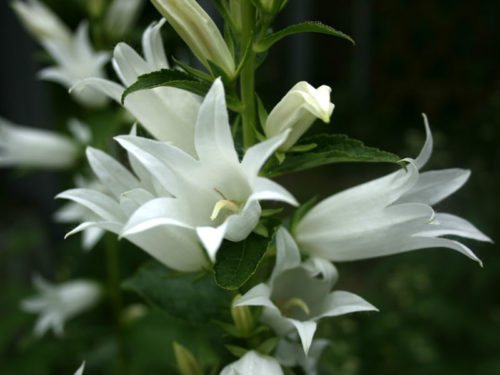

Milk-flowered campanula
White beauty with high branched stems. They are decorated with numerous milk buds, collected in pyramidal inflorescences. This is the tallest (up to 170 cm) and hardy type of bells, the bush of which can grow up to 150 cm in diameter.
There are two colors: lilac with a white center or blue with a beige neck. It is a very fragrant flowering species with a long flowering time. The most famous variety is "Paradise". This is an unpretentious bell with increased frost resistance. The variety forms a large spherical bush with large funnel-shaped flowers of various shades: from delicate milky to dark purple.


Crowded campanula
A compact form with a branched stem up to 35 cm. The flowers are large, cupped, 4-5 cm in diameter. The leaves are rich green, ovoid, the color of the buds is light blue, milky, violet.
- "Superba" - the variety blooms until the last days of August, grows up to 40-45 cm, the buds are large, pale white.
- "Akaulis" is a short hybrid with blue-white and blue-violet bells.
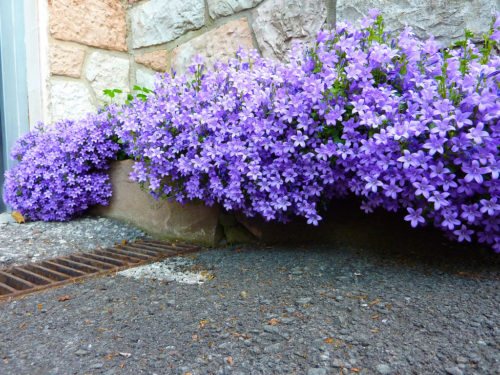

Main types
The campanula flower has not so many varieties, even fewer of those that are "domesticated" and grown by gardeners.
Among the most common varieties of this plant are:
- Campanula Alba - variety with white inflorescences and Campanula Mayl - with blue ones. Often planted in one pot or just next to it. The diameter of the bell is about 7 cm. In nature, such flowers are found among the mountains of the Mediterranean.
- Campanula Carpathian or else the Carpathian bell - this variety is grown in the open field and under the condition of a warm climate. The leaves of this variety are round, slightly elongated, ovoid, and blue in color.
- Campanula Terry - a representative of hybrids, bred on the basis of the Campanula Karpatskaya variety. The inflorescences of this plant have large buds, the leaves are terry, the color varies from white to purple.
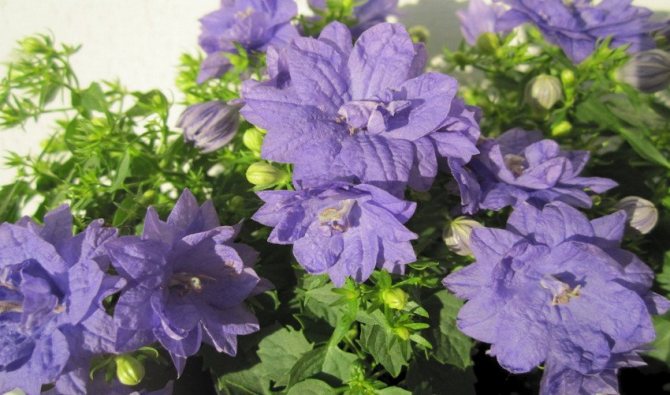

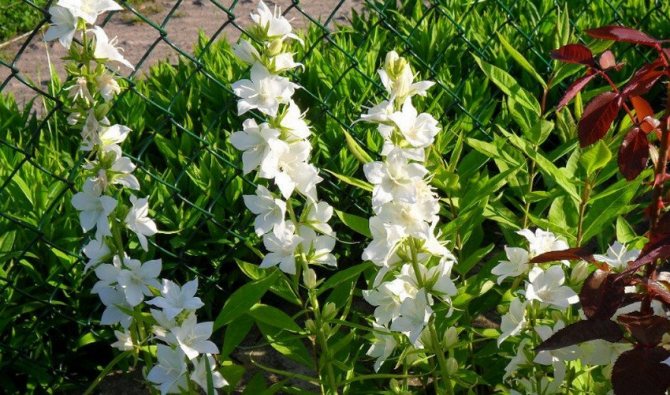

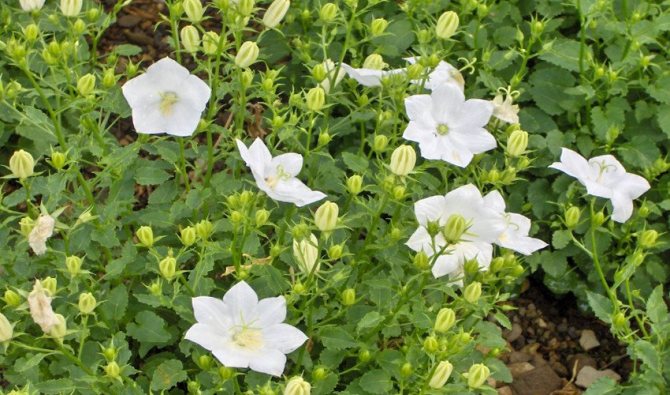

Campanula, landing in open ground
It is better to plant a campanula using the seedling method, but seed reproduction also gives a good result. This is done in late spring or in the first summer days. It is better to choose an open part of the garden, not enclosed by tall trees, dense bushes, structures. If you need to plant an already mature bush, you can do this in the fall, namely in October, so that the plant will successfully take root and prepare for the winter cold.
Sowing Campanula seeds in the ground
Having made the decision to plant bells by the seed method, you need to take into account that seeds are sown in open ground either in May or in October. On the dug-up bed, you need to form grooves, sow seeds and sprinkle with earth 3 cm. With the arrival of spring, young shoots are thinned out and, if desired, transplanted.
For the cultivation of campanula, seeds are sown in pots with light moist soil, without deep embedding. This should be done in May-June. It is better to use homemade soil, which consists of three parts of turf, six parts of humus soil and one part of sand.
Then the containers are covered with a film, and periodically moistened with a spray bottle. Two weeks later, the first shoots hatch, which after 19-21 days can be dived, and in August, transplanted to a permanent bed.
Advice! Campanula seeds do not need preparation, so they are immediately sown into the soil.


Soil selection and planting of campanula seedlings
Young shoots should be planted in a prepared bed. The soil should be dug up, without weeds. If the soil is heavy on the site, you need to add sand and humus. Since campanula is prone to fungal diseases of the rhizome, it is not recommended to use manure and peat.
You need to choose a place for a flower bed that is spacious, not swampy, and sunny. For shade-loving varieties, an area with light diffused light, but without barriers, is suitable.
Although bells are very moisture-loving, they prefer loamy soil without stagnant water, so drainage is imperative. If the soil is acidic, liming will have to be done.
The distance between seedlings depends on the species: for dwarf bells - 10-12 cm, for medium-sized ones - 20-25 cm, for tall ones - 50-70 cm.The plants are planted in prepared holes 8-10 cm deep, then the soil is trampled and watered, and the seedlings are sheltered from the sun. For the winter, young bushes should be covered with spruce branches or foliage.
Advice! Blue-violet colors of bells are just a godsend for a blooming garden. This dignity can be emphasized by a successful flower "neighborhood" with roses, clematis, aquilegia, iris, echinacea.


Growing difficulties
Despite its unpretentiousness, when growing this flower, you can encounter the following difficulties.
Does not bloom
First of all, you need to know how much campanula usually blooms. Typically, the flowering period lasts about three months, from late spring to late summer.
If the campanula does not bloom during this period of time or blooms a little and has weak inflorescences, you need to look for the reason in deviation from the mandatory rules for growing this plant:
- drafts - if the place in which the flower stands is not protected from drafts, this can lead to a lack of flowering, disease or even death;
- lack of lighting;
- wrong temperature conditions (the temperature should vary from + 13 ° С to + 22 ° С);
- lack of bait at the beginning of spring or the introduction of fresh organic matter;
- constant movement during the beginning of flowering.
Diseases
If there are noticeable traces of deviation from the healthy state on the leaves and stems of the flower (for example, the appearance of rot, leaf fall, etc.), this may be a sign of plant disease.


There are several of the most common diseases of this variety:
- Gray rot - manifests itself in the form of small spots on the plant, similar to mold, under which rot appears. The main reasons for the appearance of this fungus are considered to be frequent watering or high levels of humidity. If this disease is detected, it is necessary to cleanse the plant from all areas affected by the fungus and reduce watering, as well as air humidity.
- Yellow foliage - the main reason is direct sunlight or dry soil. In this case, it is better to rearrange the flower in a cooler place and increase watering frequency.
- Withered leaves - indicate an excessive amount of moisture in the soil. It is worth reducing the amount of water when watering and taking care that it does not accumulate on the pallet.
Campanula, care in the garden
Bells boast endurance and unpretentiousness. Therefore, if you provide the most basic care, they bloom profusely, rarely get sick and live for about 6-8 years.
Rules for watering and loosening the soil for campanula
The bell needs a large amount of moisture, but it should be supplied in a normalized manner as the soil dries out. Therefore, it is necessary to properly organize watering so that the plant does not dry out and at the same time does not rot from excess water.
You can use rainwater or well-settled water, you should water the campanula after sunset. Watering frequency is determined according to weather conditions. During the period of drought, it must be increased, otherwise the flowers become smaller, the leaves lose their brightness, the growth of the plant stops.
After each watering, the soil must be loosened. To slightly reduce the loss of moisture, the soil around the campanula is mulched with pine litter.
After the last bud has flowered, watering is reduced to 1-2 times a week, and with the arrival of cold weather, two or three waterings per month will be enough.


Fertilization schedule for Campanula
All garden forms of campanula need nutritious soil and regular feeding. Fertilizers need to be applied at least three times per season:
- In May-April, nitrogen-containing fertilizers are used, which ensure good foliage development.
- At the stage of bud formation, complex mineral compositions are the best choice.
- Flowering period - fertilizers with a high content of potassium and phosphorus are applied.
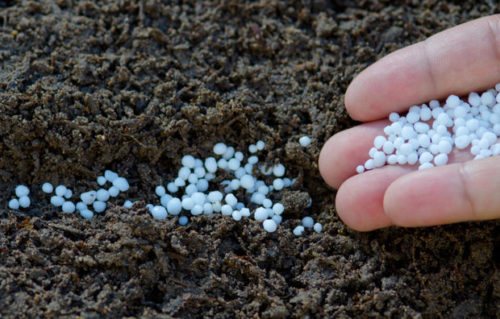

Pruning, transplanting and dormant period of campanula
Bells bloom, as a rule, in the second year of life. Often they release several peduncles at once. This greatly depletes the young plant, so it is better to cut off the extra flower arrows so that the campanula can fully strengthen.
The activity of growth and the abundance of flowering is influenced by the flow of oxygen to the rhizome. Therefore, it is important to regularly loosen the soil near the roots and remove weeds in a timely manner. Also, do not forget to remove faded inflorescences.
Bells react capriciously to a transplant. If there is such a need, it is better to transplant at the end of summer. When digging a bush, always leave an earthen lump on the roots to reduce their trauma to a minimum. After 19-21 days, you need to feed the roots.
The campanula bell withstands frosts well, but for this it needs preparation. Experienced gardeners advise to cut off the aerial part before the arrival of winter, leaving stalks 10-15 cm long. Such care will allow the plant to overwinter calmly, and release strong young shoots the next year.
In regions with harsh winters, it is best to cover the bells with foliage or other scrappy material. But in the spring it needs to be removed as soon as possible so that the flower does not come out.
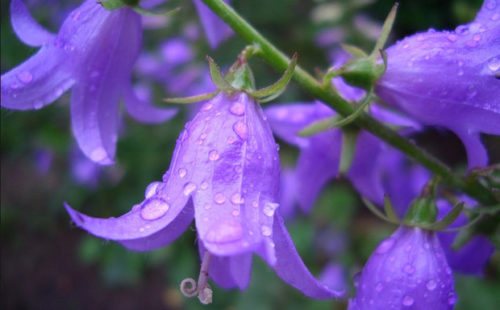

Campanula care
At first, the plant needs shading in bright sunlight. Otherwise, caring for the campanula consists in maintaining the minimum conditions for normal cultivation:
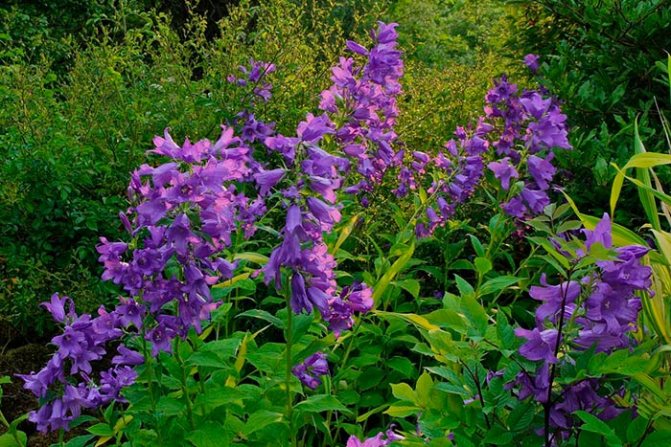

It is very important to regularly loosen the soil around the plant.
- The soil should be constantly moist, especially in spring and summer. Gardeners recommend adding small amounts of water, but do it 1-2 times a day. Reduce watering in the fall. Use water at room temperature.
- Loosen the soil constantly. Oxygen access to the roots is a key factor in successful flowering.
- Weed periodically.
- Too tall plants should be tied up.
- Prune the crop in October. Then cover the root zone with dry foliage or peat to protect perennial roots from frost.
- Remove wilted buds to maintain a rich and vibrant bloom.
Home cultivars
Campanula is commonly used in landscaping, but some varieties are suitable for home cultivation. The following varieties are considered the easiest to care for:
I. Equivalent Campanula
A plant grown in ampelous form - its shoots hang under their own weight. It blooms with white and blue flowers, has small leaves.
II. Campanula Carpathian
A perennial variety of bluebells. Differs in a rounded shape of leaves and a wide variety of shades of flowers. Forms a rounded beanie.It blooms throughout the summer, then a dormant period begins.
III. Campanula Blauranca
This variety emit large flowers and leaves, while the bush itself does not grow higher than 20 cm. Flowers, as a rule, are blue in color.
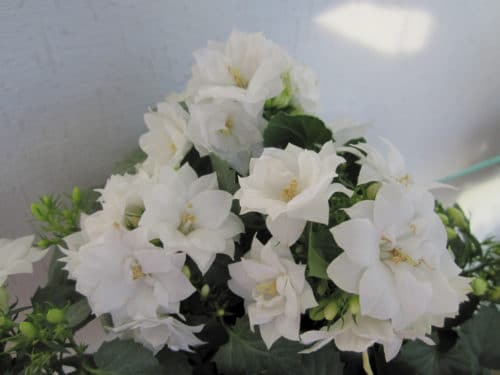

Terry campanula also belongs to the varieties that are bred at home, however, it is very demanding to care for. This variety is distinguished by special "double" flowers from several rows of petals.
"Home" types of bells
Usually, on our windowsills and balconies, the subspecies of the campanula is flaunting: "Alba" (Alba) and "Maya" (Maya). "Alba" has white inflorescences, for which the people called her "the bride". "Maya" is blue, she is called "the groom". And there are also two-colored plants - "Bicolor", the popular name "lover". But in fact, sometimes there are other varieties of campanula, for example: "Karpatskaya", "Makhrovaya", "Blauranka". The table shows the distinctive features of the most common plant varieties.
Read also: How to use the covering material "Agrotex"
Table - Varieties of "domesticated" campanula
Flower rest period: winter care
With the onset of autumn, the active growth and flowering of the plant stops. During this period, it is necessary to prepare the flower for the rest period. In order for the plant to more easily come out of the dormant period in the spring, it is necessary to carry out some manipulations.
Let's see how campanula winters:
- It is necessary to prune the shoots, leaving 10 cm of branches.
- The plant should be kept in a cool (12-14 ° C) room, but well lit.
- Watering should be reduced to once a month.
- When spring comes, the plant is brought to a warm place. It is necessary to remove dried parts of the flower and watering more often.


Why does not it bloom
Campanula garden perennial - planting and care
To bloom campanula, you need to follow some rules:
- The flower must be protected from drafts.
- The plant should be well lit. Sunlight should be diffused.
- It is forbidden to move the plant in the spring.
- The ambient temperature should not be higher than 22 ° C.
- At the beginning of the growing season, feeding should be applied once every two weeks.
- Shoots should not be cut in the spring.
- Flowers bloom only with regular watering. The earthen ball in the pot should always be moist.
Important! Excess water from the sump should be drained. Stagnant water can lead to root rot.
The reason for the absence of flowers on the plant may be age. In this case, a new plant should be planted from seeds or cuttings.
Reproduction methods at home
Dividing the bush
When you plan to transplant a plant, during this period it is possible to divide the root into several parts with a sharp knife. Plant each part in a separate pot. The plant is watered and fertilized after a week.
Cuttings
Campanula can also be produced propagation by cuttings.
This is the easiest way.
Stages of cuttings:
- Choose a cutting that is suitable for propagation. It is better to take it from the bottom of the plant.
- Then it immediately needs to be planted in a mixture of peat and sand, periodically watering.
- It is advisable to make a greenhouse by covering the pot with a jar or transparent plastic, sometimes airing it.
- When the cutting reaches 10 cm, it is necessary to pinch, which will promote the development of lateral shoots.
Consider how you can grow Campanula from seeds. In this way, you can start growing Campanula in early spring.
The very small size of the seeds means they can be sown in small glasses. Wet soil is placed on the bottom, and dry on top, the seeds should not be watered - it is better to spray, so it will be easier for them to germinate.
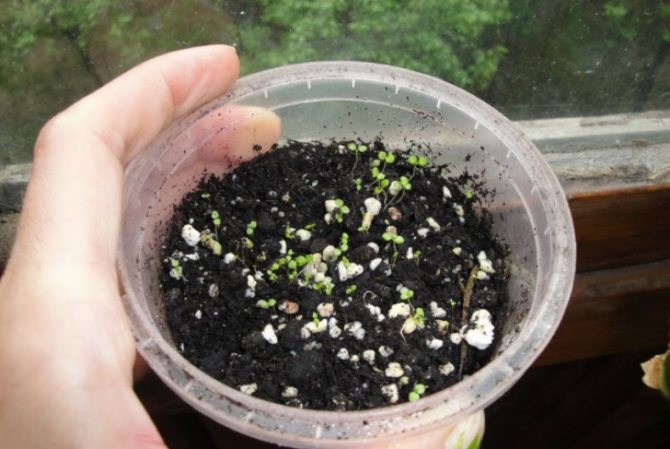

The future plant needs to provide a warm environment, moderate watering and adequate lighting.
It is worth replanting campanula from a glass when the plant has at least three leaves.
Considering the recommendations for growing campanula, you will get a healthy plant that will delight you and those around you with its abundant and beautiful flowering.
How to deal with Campanula diseases
Clerodendrum Thomsoniae flower - home care
The appearance of problems with the flower indicates improper care. If the irrigation regime is violated, the plant is exposed to fungal infection. To eliminate the damage, watering should be reduced.
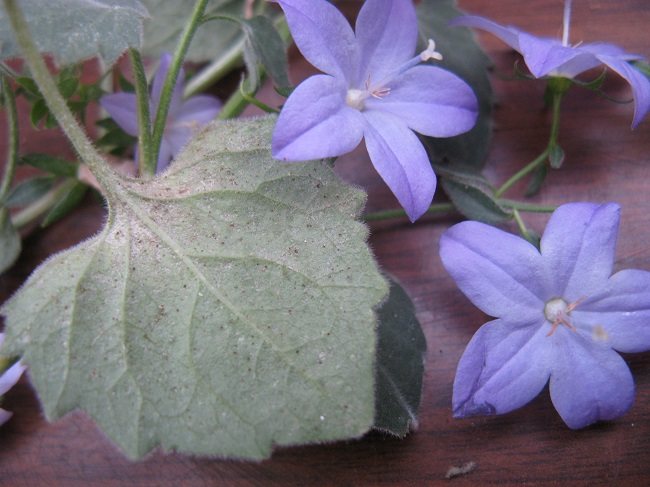

Scabbard on the leaves
Also, a spider mite and a scale insect may appear on the plant. To eliminate pests, the flower is treated with an insecticide, you can also wash them off with warm running water.
How to propagate a bell
Again, Campanula is not a perennial. The average life span of a plant is two years, sometimes a little more. If you do not want to say goodbye to the "shooting star" a couple of years after purchase, multiply it. You have several ways to choose from:
When you carry out spring pruning, pinch off the heel cut from the mother plant. That is, you need to tear off the young shoot at the very bottom so that part of the skin and core of the mother stem remains on it. And at the bottom of the cutting there should be two or three leaves. Follow these five steps to root Campanula with cuttings.
By dividing the bush
Campanula can be propagated in this way directly during plant transplantation. It is better to do this in spring or at the very beginning of summer. Here's a seven step guide.
- Remove the bush along with the clump of old earth.
- Divide it into several pieces - just cut the roots with a sharp knife.
- Delenders should not be too small.
- Place each piece in your pot. Don't forget to put a drain on the bottom.
- Deepen the plant 2-3 cm into the ground.
- Top up with the required amount of soil and tamp lightly.
- Water the plant.
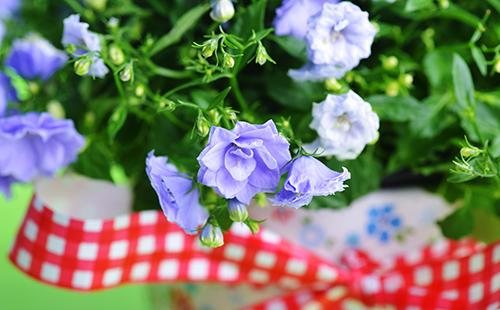

Propagation of campanula by seeds is carried out in the spring, at the beginning of March. This is if you already have a mother plant. Or buy seeds from the store. So, in the fall, when the bell has faded, look for miniature boxes on the stems - there are seeds. But do not rip off the box - let it remain on the plant, it will burst itself when the seeds "ripen". Campanula seeds are very small, more likely to resemble dust, they can even be blown off by carelessness. Then follow the six-step instructions.
- Carefully open the "house".
- Prepare a clean container and suitable soil.
- Spread the seeds as evenly as possible on the ground.
- It is not necessary to deepen the seeds. Just sprinkle them with a little soil or sand.
- Spray the soil with a spray bottle.
- Cover the seedlings with plastic wrap and air them daily.
Usually indoor flowers infect two pests: spider mites and scale insects. If you notice a parasite on at least one plant, there is a high risk of infection for all "neighbors". Isolate the diseased plant immediately and immediately start fighting the "enemy".
Spider mite
If you notice "cobwebs" between the base of the leaves and the stem, this is a reason to think. Inspect the inside of the leaves, if you notice something that looks like stuck earth - poke the "dirty" place with a thin needle or toothpick. It turned out to be not dirt at all, but scanty brown bugs that scattered about? This is a spider mite. First, break off all the infected leaves, so you will already get rid of a large number of pests. And what to do next is described in the table.
Read also: How to get rid of wasps at their summer cottage
Location and lighting for growing campanula
Campanula likes diffused bright light. It is better to protect the flower from the sun's rays. It will feel great if placed on a west or east window. When placed in the southern part of the house, the campanula must be shaded. If you notice that the leaves of the campanula are curling and withering, then most likely this is due to excess sun.If it receives less light, the shoots become elongated, the leaves are at a distance more than usual, and the flower loses its former appearance. When there is no way out, and the home campanula must be placed on the north window, then it is imperative to organize additional lighting for at least two hours a day.


Reproduction of campanula
Different types of campanula flower require approximately the same care at home, and their reproduction is also no different. Each flower can be propagated by seeds or cuttings, both methods require a clear execution of the algorithm, they are equally successful and have both their pros and cons.
Campanula - propagation by cuttings
Reproduction by cuttings is carried out only in the autumn season. It is done according to the following scheme:
Campanula from seeds at home
Campanula is also capable of propagating by seeds, the key is when to plant the seeds. This breeding method can be successful only in spring. For seeds, you need to take small cups, into which a small layer of wet soil is applied, a layer of dry soil is placed on top, and the seed is placed. It is not necessary to water the seeds, it is only important to periodically spray them from a spray bottle.
Seeds sprout relatively quickly, without requiring special care, depending on the temperature and moisture of the soil. Do not rush to transplant sprouts into a pot - this can be done only after at least three leaves appear on them. Otherwise, the small plant may not cope with the stress of the transplant and die.


Campanula withered - how to revive?
For all its unpretentiousness, this flower will not tolerate complete neglect or mistakes in care. If, for some reason, all or part of the campanula has dried up, what to do, is it possible to save the plant? First of all, let us tell you the bad news - if the flower has dried up completely, nothing can be done, it died. If the campanula began to dry out partially, you can try to reanimate it. The first step is to understand the cause, which can be anything from dry soil to a disease, and eliminate it.
If all the shoots of the campanula began to dry out from above, but the bottom of the plant at the root is alive, you can cut the flower almost to the root and provide ideal conditions for it - soil, temperature, fertilizer. If the root system is alive and well, there is a high probability that the flower will come to life safely and soon start up new shoots.
If the plant still has green shoots, even if not quite strong and full of life, they should be cut off and tried to root. This is done in the same way as the reproduction of campanula at home by cuttings described above. If there are several shoots, it is highly likely that at least one of them will live.
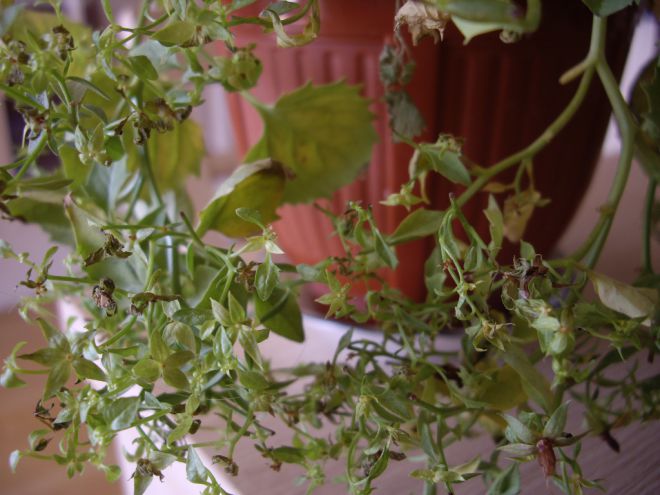

Diseases of room campanula and the fight against them
Even if the campanula flower gets perfect home care, this cannot completely insure it against diseases and pests. The good news is that almost every problem can be dealt with if it is recognized on time. What can campanula get sick with?
Does Campanule need pruning
This wonderful flower needs pruning.
Pruning dried bells stimulates flowering. Waiting for the moment of their independent falling away slows down this process. Dry shoots are also removed. Before the dormant period, after the cessation of flowering and growth, long, thinned branches are shortened. The shoots are shortened by ⅓. It is advisable to leave 4-5 internodes. Then the campanula is removed to a cool place.
The next pruning is done in January-February. Before moving the plant to indoor conditions, all shoots are cut off to rejuvenate it by ⅔ of the length. Remove dried, damaged shoots.


It should be borne in mind that not all varieties tolerate the rejuvenation process. When buying in a store, it is advisable to clarify this point.
Landing rules
When planting, the substrate for campanula is prepared from leafy soil, sod, sand and peat.It should be a loose, breathable, slightly alkaline mixture. You can purchase a ready-made universal substrate in the store.
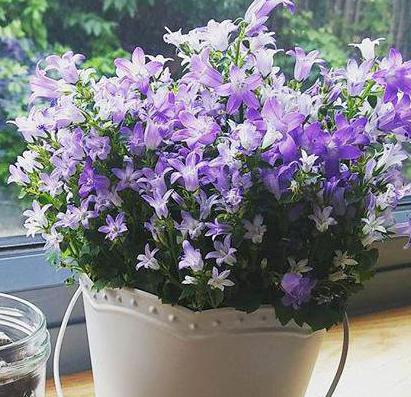

A flower pot (even when planting a small stalk) must be taken wide and large, since the root system grows very quickly. Do not water the plant abundantly immediately after planting. It is enough just to spray on the first day.
Professional recommendations
- Campanula are not a perennial plant and live on average 1-2 years. To preserve a flower, it can be propagated by cuttings;
- The pot should be wide, but not very deep, since the plant has a shallow root system;
- Equivalent Campanula grows best in hanging ampel pots on a balcony or veranda.


In the summer, the home potted campanula can be taken out into the open air, used as a garden or veranda decoration in the country or in a private house.
Watering the campanula
- Bred in areas of southern Europe, the plant can in principle tolerate drought.
- But still it is necessary to water the campanula at least once a week, especially during the flowering period.
- This flower may not withstand excessive moisture, so it is important to ensure that water does not accumulate on the pan of the pot.
- As for spraying a plant, you should also not "be zealous" when flowers are tied on it, it is better to cancel spraying altogether.


Garden, vegetable garden and flower garden tips
The waning moon in August 2019 when from what date to what date
Moon phases in August 2019 by day for gardeners and truck farmers
The growing moon in August 2019 when from what date
Simple care tips
It is better to buy a plant not in a store, but from other flower growers. It is more adapted to indoor conditions. Shop flowers are more likely to die as they are overfed with stimulants. Immediately after purchase, within 2-3 days, you must:
- without regret, cut the purchased bush, remove the buds and opened flowers;
- transplant the home bell into another container and completely change the soil;
- carry out pest control.
In just a month, buds will appear on it. Then the roots will strengthen, new lateral branches and shoots from the roots will grow. The bush grows very quickly. Bells have a short lifespan - 2-3 years. A systematic update or grafting is required (read more about this below).
Practitioners advise growing the "groom" and "bride" side by side, as they cross-pollinate each other and bloom better.
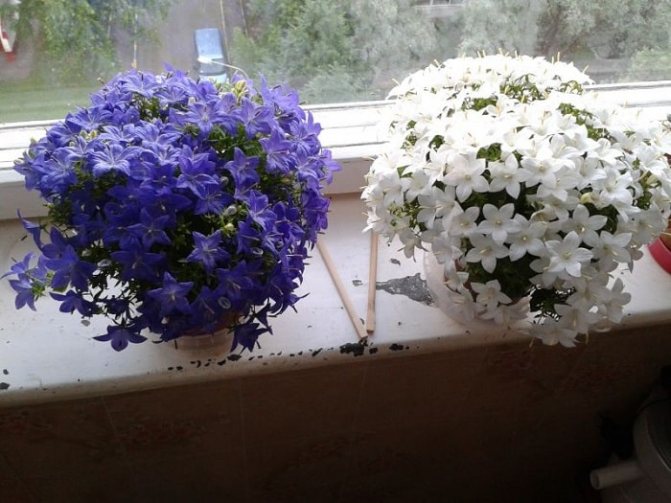

Separate seating of the bride and groom
Lighting
Campanula needs bright but diffused lighting. Its successful placement on the windowsills in the eastern, western or northwestern part of the house.
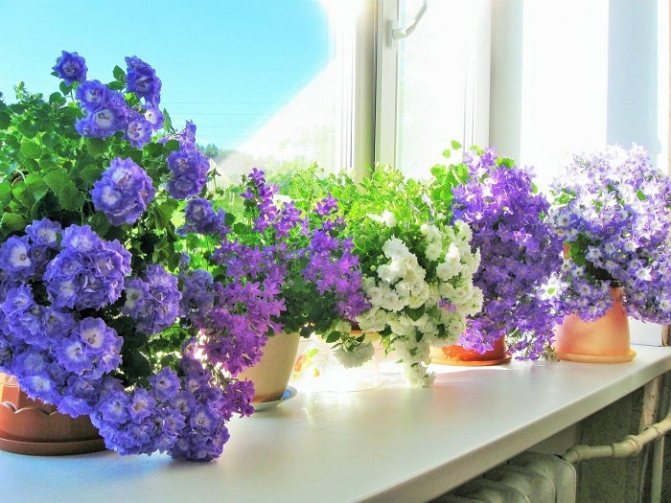

Campanula lighting
It is imperative to shade it on the southern windows. She feels uncomfortable on them.
Lack of light leads to stretching of the stems, an increase in the distance between the leaves, a loss of compactness and beauty of the bushes.
Temperature regime
Bells don't like heat. The optimal temperature range for growing them is 20-22 ° C, and during winter dormancy - 12-15 ° C, but not lower than 7 ° C. Warm wintering is reflected in flowering. It is being formed very poorly.
In the summer they take her out into the street, select a place for her in a light shade.
Watering requirements
In warm seasons, you need to make sure that the soil remains moist inside the pot, but dries out from above. Avoid drying out or waterlogging the soil. The water flowing into the pan should be drained to prevent root rot damage to the flower.
In the fall, from the time of the end of flowering, watering is gradually reduced. In winter, when dormancy sets in, the plant is watered sparsely.
Morning is the best time to water. Better to water with warm water.
What feeding does Campanula need?
She needs regular feeding during the period of active growth and flowering. Once every 10-20 days, it is fed with fertilizers for flowering indoor plants.It is good when they contain iron, boron, zinc, magnesium.
Once a month, the plant is fertilized after flowering. Stop feeding during the rest period.
Air humidity
Campanula feels comfortable both in a greenhouse and in a city apartment. On hot days, spraying is beneficial for her. Water drops are allowed on flowers and buds.
What feeding does Campanula need?
She needs regular feeding during the period of active growth and flowering. Once every 10-20 days, it is fed with fertilizers for flowering indoor plants. It is good when they contain iron, boron, zinc, magnesium. Helpful advice. It is recommended to reduce the rate by half of that specified by the manufacturer. Once a month, the plant is fertilized after flowering. Stop feeding during the rest period.
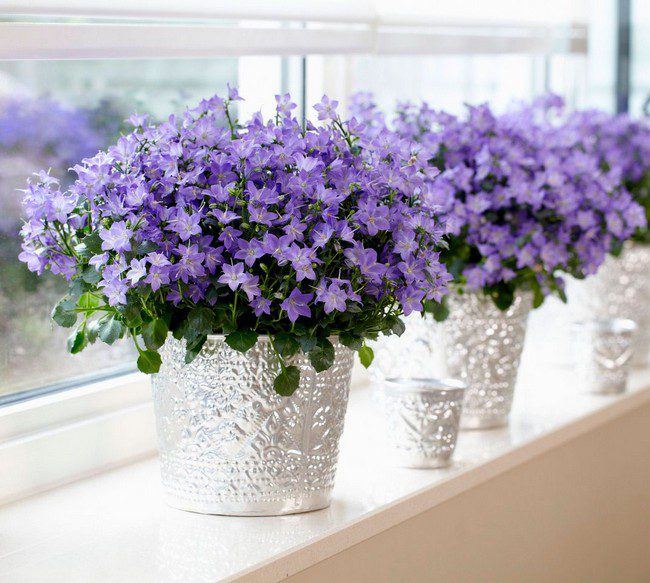

Garden, vegetable garden and flower garden tips
Kupena: planting and care in the open field
How to drive ants out of the garden
When can you plant strawberries in the summer with a mustache?
Note to the florist
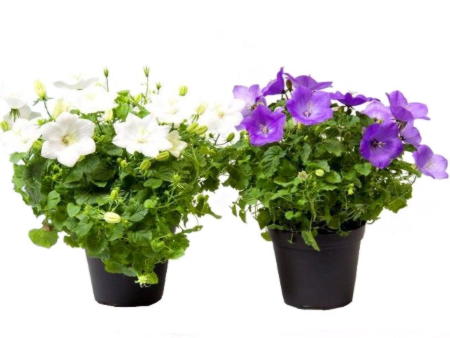

Why doesn't campanula bloom?
- Perhaps your plant is already old, its life cycle is coming to an end. It is necessary to update the flower by planting new cuttings in the pot in the spring.
- Insufficient flowering can be caused by a lack of light. Just move your campanula to a sunnier location. In summer, bells feel good outdoors - on the balcony or in the garden.
- Lack of trace elements can also lead to the lack of flowers. After all, a plant needs a lot of strength to bloom. Feed the plant every two to three weeks with complex fertilizers for flowers. Just don't overdo it, in this case, more doesn't mean better. To feed the campanula, you can use a complex fertilizer for flowering plants "Etisso" or "Kemira-Lux".
Why does campanula wither?
- First of all, you should adjust the watering mode. Campanula does not like drought, but also does not tolerate excessive moisture and stagnant water.
If you notice that the plant has become lethargic, and the soil is too moist and an unpleasant odor comes from it, the root system may be affected. The plant must be transplanted into a new pot, while removing all rotten parts of the rhizome.
- In too bright light, campanula flowers quickly fade and wither. Shade your plant a little.


